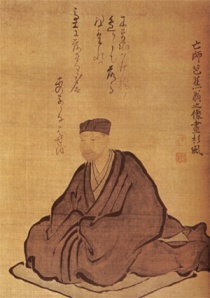A lot of traditional Japanese art draws from the concept of Ukiyo the “Floating World” where all life is a fleeting transient thing. The origin of this term was the hedonism of the early Edo period but it was also an allusion to the Buddhist “Sorrowful World” which is the earthly plane of death and rebirth.
The Japanese love of nature and the seasons also draws from this melancholy for the passing of things. From Hanami, the cherry blossom viewing festival to Tsukimi the autumn moon viewing festival Japanese cultural and spiritual life is filled with a kind of worship for the temporary beauty of nature. The goal then for a lot of Japanese art is to capture these fleeting moments of awe at the worlds beauty.
Given the nature of the Japanese language where all phonemes are consonant and vowel pairs and all words then end in one of six sounds, rhyming poetry would be neither challenging nor interesting. So Japanese poetry has evolved instead from syllabic rhythm.
The Haiku, now considered the standard poetic form has seventeen syllables divided into lines of 5-7-5 syllables. A haiku usually contains just one image drawn from nature.
The Tanka is a slightly longer poem with thirty-one syllables in two parts 5-7-5 syllables and 7-7 syllables with one image in each part.
The Choka is a long poem. It contains 5 and 7 syllable lines and is indefinite in length.
The Kyoka “mad poem” is a satirical Tanka not necessarily based on nature.
And the Senryu is also a satirical poem about human foibles in the Haiku form.
It is perhaps not surprising given the fascination with fleeting things that Japanese poetry might be used to capture someones last moments of reflection. It is perhaps the most awesome and terrifying moment of our lives aside from our birth which we are incapable of recording. The earliest death poems appeared in the sixth century. However the writing of death poems became a widespread practice in the Meiji period (1868-1912). Death poems were often included with a persons will written not only by poets and court nobility but at all levels of society. Samurai were known to ride into battle with their death poem tucked inside their armor so that if they died it could be carried back to their families.
Death poems could be seen as a memorial of a persons life or a message to people left behind.
Prince Otsu, was executed after being unjustly accused of conspiring to the throne.
Momozutau
Iware-no-ike ni
naku kamo o
kyo nomi mite ya
kumogakurinamu
(This is the last day
I shall see the mallards
crying over Lake Iware.
Then shall I disappear
into the clouds.)
Yorimasa wounded and his army defeated turned to the west and chanted “I put my trust in the Amida Buddha” and then recited this poem before plunging his sword into his stomach.
Umoregi no
hana saku koto mo
nakarishi ni
mi no naru hate zo
kanashikarikeru
(Like a rotten log
half-buried in the ground
my life, which
has not flowered, comes
to this sad end.)
Ota Dokan was stabbed while bathing. He is said to have recited this Tanka and then died.
Kakaru toki
sa koso inochi no
oshikarame
kanete nakimi to
omoishirazuba
(Had I not known
that I was dead
already
I would have mourned
my loss of life.)
Chikamasa:
Umarenuru
sono akatsuki ni
shininureba
kyo no yube wa
akikaze zo fuku
(One day you are born
you die the next
today,
at twilight,
autumn breezes blow.)
Takemata Hideshige lost a battle to his rival Shibata Katsuie and before dying he recited this poem.
Ashura o ni
ware o torameya
yagate mata
umarete toramu
Katsuie ga kubi
(Shall Ashura[a demon of war]
subdue a man like me?
I shall be born again
and then I’ll cut the head
off Katsuie…
Oroku was cruelly treated by her mother in law and finally committed suicide. This poem was included with her will.
Nagarete
kono yo no yami wa
yomo hareji
shide no yamaji no
iza tsuki o min
(And had my days been longer
still the darkness
would not leave this world
along deaths path, among the hills
I shall behold the moon.)
For some , especially the zen monks, the death poem was just a vanity. Toko wrote:
Jisei to wa
sunawachi mayoi
tada shinan
(Death poems
are mere delusion
death is death.)
And Kisei:
Umarete wa
shinuru hazu nari
sore naraba
(Since I was born
I have to die,
and so…)
Some took a lighter approach. Hanabusa Ikkei wrote:
Ni sambyaku
ikiyo to koso
omoishi ni
hachijugo nite
fuji no wakajini
(I thought to live
two centuries, or three
yet here comes death
to me, a child
just eighty-five years old.)
And Moriya Sen’an:
Ware shinaba
sakaya no kame no
shita ni ikeyo
moshi ya shizuku no
moriyasennan
(Bury me when I die
beneath a wine barrel
in a tavern.
With luck
the cask will leak.)
And finally from an anonymous poet:
Inashu wa
jisei o homete
tatarekeri
(The doctors
praise his death poem
and depart.)
How we live and our thoughts at the end of that time, whether an act of vanity or not, offer a unique record of a persons life and of the lives of a people.
The translations of the death poems I’ve used here come from “Japanese Death Poems” by Yoel Hoffman. A good book if you are interested in reading further.


Thank you for the amazing poetry. This type of poetry is the reason I love to read poetry from other places and cultures.
Pingback: When Cherry Blossoms Fall